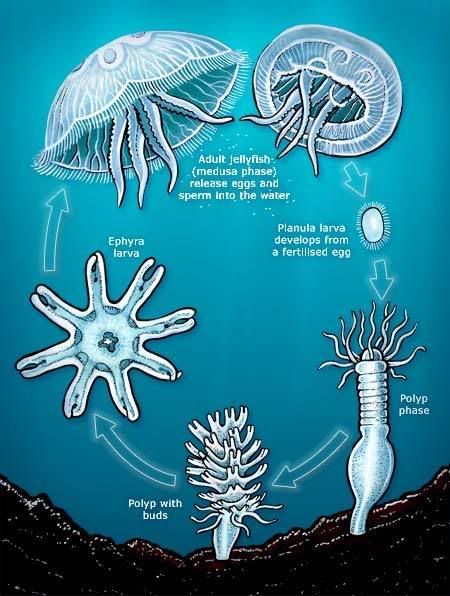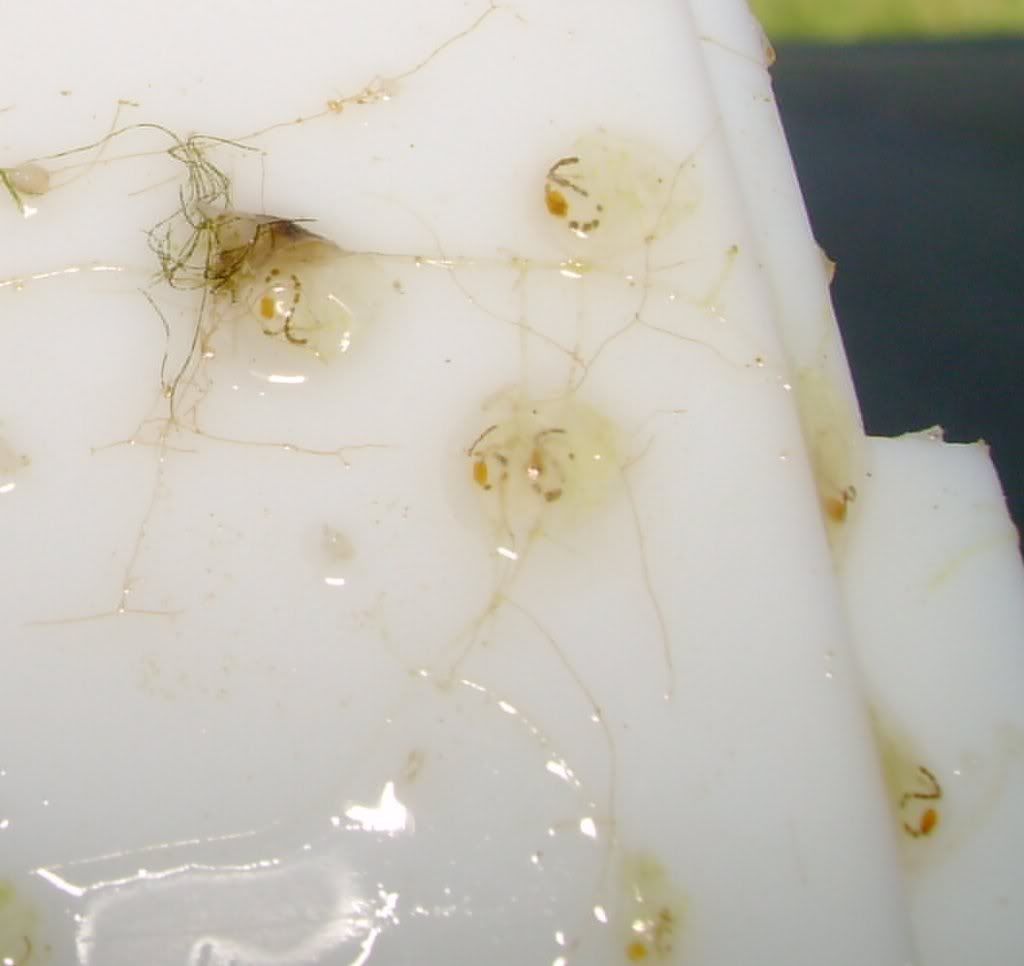


|
 |
|
|
#1 |
|
Registered Member
|
Hydroids or not hydroids?
I started getting little snowflakes on my glass of my new 10G tank. I've never seen them before, so I do a search and lo and behold, everybody is calling these things "hydriods". Funny. To me, hydriods in this stage are little blobs that look like a snail egg that have long, near-invisible streamers trailing them in the water. When they hit rock, they grow into those ugly brown feather-duster like tubes that dominate the entire tank. Somebody actually posted to somebody here at RC that it was better to have hydroids than aptaisia. Pffft. There are either two types of hydroids or he has a few screws loose.
|
|
|

|
|
|
#2 |
|
is a serious goby fanatic
Join Date: May 2002
Location: New Haven, CT
Posts: 7,033
|
I seriously think that person has lost their mind. Hydroids BETTER than Aptasia? He's smoking crack. Hydroids are the worst POS thing I can think of...and I've got the scars to prove it.
I got those on my glass Scott and I had read that they were one of the stages of the hydroid life cycle. Now before everyone goes and gets all shocked...yes...I did read reef-related literature about hydroids. I know...shocking...shocking I tell you! |
|
|

|
|
|
#3 |
|
Registered Member
|
I reckon there are two different types of hydroid jellyfish, then. When mine were actively spreading (the medusa stage), they never looked like those snowflakes -- they were little blobs of jelly with stringers behind them. This is the first I've ever seen snowflakes -- but I defintely have a hundred thousand hydriods at home.
If I see any of the hydroid stalks growing in my work tank, I am going to nuke it -- take everything out and throw away the tank and start over.
__________________
-Scott "During times of universal deceit, telling the truth becomes a revolutionary act." -George Orwell Current Tank Info: 24G Reef cube with Cree LED DIY Retrofit |
|
|

|
|
|
#4 |
|
is a serious goby fanatic
Join Date: May 2002
Location: New Haven, CT
Posts: 7,033
|
I don't think it's two different kinds... I think it's two stages of the life cycle...or at least that's what I read and it makes sense from what I've learned in my classes at school.
For some jellyfish, there's a sessile stage (non-motile) and a medusa stage (motile). I'm going to go look on the interweb... ...OK...this isn't a diagram of hydroids necessarily, but it's what I was envisioning from back in school about jellyfish life cycles:  I'm with you on nuking the tank though. Go for it...abso-frickin'-lutely. |
|
|

|
|
|
#5 | |
|
Registered Member
|
Sheesh. Apparently there are dozens of hydrozoans:
Quote:
__________________
-Scott "During times of universal deceit, telling the truth becomes a revolutionary act." -George Orwell Current Tank Info: 24G Reef cube with Cree LED DIY Retrofit |
|
|
|

|
|
|
#6 |
|
Reefing On My Mind
 Join Date: Apr 2006
Location: Kempton, IL
Posts: 8,083
|
I have two types of hydroids... I'll try and take some pics...

__________________
Randy Volunteers, Blackhawks, Titans, Cubs!!!! Current Tank Info: 185g waiting to be built, 120g SPS/Anemone Reef, 120g SCA in the works, 58g mixed reef w/ 6x39w T5, 125g grow out w/ Reef Breeders |
|
|

|
|
|
#7 | |
|
Registered Member
Join Date: Jan 2007
Location: Pacific Northwest
Posts: 1,789
|
Quote:
 How can you differentiate between hydroids then, and just little feather dusters? I have tons of little brown tubes with what I thought were mini feather dusters coming out of them. Now I'm worried... How can you differentiate between hydroids then, and just little feather dusters? I have tons of little brown tubes with what I thought were mini feather dusters coming out of them. Now I'm worried...
|
|
|
|

|
|
|
#8 |
|
Registered Member
Join Date: Apr 2004
Location: Chandler, AZ
Posts: 4,492
|
I have several types of hydroids in my tank.
I had the snowflake ones on the glass when the tank was new. There were a lot of them. They were harmless and eventually disappeared on their own as the tank matured. These are harmless, grow on SPS:   These go through the different stages, but haven't seemed to spread any more than this tiny little patch of them:  And these which are the plague!!! Horrible fast spreading monsters!! I have been fighting this battle for over a year. 
|
|
|

|
|
|
#9 |
|
Registered Member
|
These are feather duster tube worms:
 The brown tubes that grow in clumps and spread across rock and have the fuzzy little tenticles are hydroids. Apparently the snowflakes are the medusa stage of one type and the jelly blobs are the medusa stage of another type. I've only seen the jelly blob kind, though. I hope the snowflake ones are pansies and don't grow into tubes very well. 
__________________
-Scott "During times of universal deceit, telling the truth becomes a revolutionary act." -George Orwell Current Tank Info: 24G Reef cube with Cree LED DIY Retrofit |
|
|

|
|
|
#10 | |
|
is a serious goby fanatic
Join Date: May 2002
Location: New Haven, CT
Posts: 7,033
|
Quote:
Also, the tubes are soft, not hard and calcium-based like many feather duster worm tubes. In addition, the tubes tend to grow in clumps, meaning that they usually aren't single solitary tubes. They seem to grow like a bunch of flowers would (imagining daffodils). Last edited by EvilMel; 11/02/2007 at 09:15 AM. |
|
|
|

|
|
|
#11 |
|
Moved On
Join Date: May 2007
Location: Right next to you
Posts: 448
|
Here is a pic of the crap I pulled out of a filter, something I thouht were cool neon green glowing feather dusters wound up being hydroids. The pic shows the actual jellies that were alive in the filter.

|
|
|

|
|
|
#12 |
|
Moved On
Join Date: May 2007
Location: Right next to you
Posts: 448
|
I grab ahold of something and got stung and then I looked and saw it was covered in jellies.
|
|
|

|
|
|
#13 |
|
is a serious goby fanatic
Join Date: May 2002
Location: New Haven, CT
Posts: 7,033
|
Linty...that's not what I have seen and called hydroids. It doesn't mean that that's not hydroids of another kind, but it's not the ones I had. In addition, mine wouldn't hurt when I would initially touch them...just itch and hurt like hell later on when I had the deep blisters coming up.
Man, there are so many bad bugs out there. |
|
|

|
|
|
#14 |
|
Moved On
Join Date: May 2007
Location: Right next to you
Posts: 448
|
I cant remember the exact name but it was hydrozoan something.
Under actinics, thier polyps glow neon green. or they did before I took the torch to all the rock I had. |
|
|

|
|
|
#15 |
|
Moved On
Join Date: May 2007
Location: Right next to you
Posts: 448
|
Those were also tiny, look a lot bigger in the pic, 1" or less total length, the cap was maybe 1/4" or smaller.
|
|
|

|
|
|
#16 |
|
Premium Member
 Join Date: Nov 2006
Location: Lancaster OH, Kansas originally
Posts: 1,244
|
Hey runner My copperband would be fat with those feather dusters he wouldnt stop till they where all mowed off.
|
|
|

|
|
|
#18 |
|
Registered Member
|
A hydroid has grown in my 10G tank now, but it is one of the whispy little pathetic-looking ones -- not the big brown bad ones.

__________________
-Scott "During times of universal deceit, telling the truth becomes a revolutionary act." -George Orwell Current Tank Info: 24G Reef cube with Cree LED DIY Retrofit |
|
|

|
 |
|
|